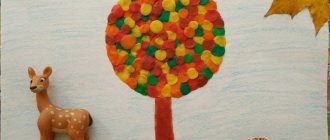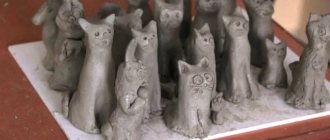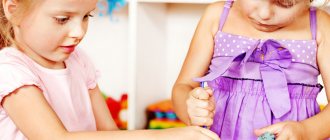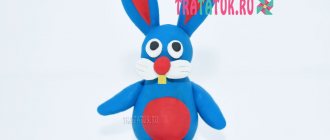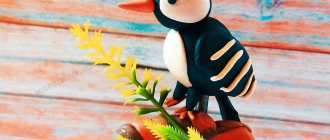MOLDING IN A PREPARATORY SCHOOL GROUP
Features of the plastic form created by children of the preparatory group for school
Modeled products of children in the preparatory group are more expressive, more interesting and varied than those of 5-year-old children. This is explained by the fact that they have accumulated a larger stock of visual images. The children's hand muscles have become stronger. Speech and thought processes were further developed. During observations, 6-year-old children more fully perceive the phenomena of the surrounding reality and the shape of objects. They become better oriented in space and begin to understand how objects can be arranged in relation to each other. Changes in development lead to changes in the nature of visual activity. Children develop a desire to more accurately convey shape and proportions; they begin to be fascinated by the image of details and objects that complement the image. Children understand that the arms and legs of figures to depict steps and other actions can not only be placed and raised, but also bent, as a result of which the sculpted figures become more expressive. In addition, they can immediately determine in what position the depicted object should be and set the main part accordingly. For example, a child immediately determines the position of a piece of clay when depicting a running hare or a sneaking fox.
Compared to the older group, children increasingly use the method of pulling from a whole piece and widely use the stack, performing many operations with it.
Despite the fact that the entire process of creating an image has become more creative and independent, the form, sculpted with a greater understanding of its structure, continues to remain very generalized, for example, the head is often depicted in the form of a ball, the body - ovoid (oval) in shape. This indicates that 6-year-old children do not yet have access to a complete image of all the features of the form, and they convey only its basis, unconsciously discarding the complexities of the structure. But in order for children to be able to depict an object, even in such a generalized form to make it understandable to others, they must clearly imagine the appearance of the object with all its features.
Learning Objectives
The curriculum for children in the preparatory school group is much more complex and varied compared to the program for the senior group.
Children must learn visual and muscular perception of the shape of an object, use various expressive means in modeling, and also master visual and technical techniques. Children 6 years old, as a rule, use many methods of depiction, but the main one should be the plastic method - sculpting from a whole piece.
At the same time, relying on previously acquired knowledge of volumetric bodies (cone, sphere, ovoid, cylinder), children must independently determine the initial shape for sculpting objects.
The teacher, developing creative initiative, gives them the opportunity to independently choose topics, means of expression and methods of depiction.
All listed tasks are specified by quarter.
Completion of the program
I quarter
In the first quarter, the teacher is faced with the task of teaching children to sculpt the characteristic shape of objects. To do this, at the beginning of the year they are asked to depict vegetables and fruits. If in the older group children sculpted vegetables of different shapes (cucumber and beetroot) in order to better understand their characteristics by contrast, then in the preparatory group the task became more complicated: children were asked to sculpt two homogeneous objects of different shapes, for example, one oval-shaped apple (Crimean) , and another round shape (Antonovskoye), several types of cucumbers, etc.
You can use sculpted fruits or vegetables to create a common composition with your children on a plate, in a basket or in a vase. With repetition, anyone can create a small composition from their imagination from sculpted vegetables or fruits, but for this it is better to use not clay, but plasticine, the color of which will be an additional means of expression.
Children should be taught to create figures based on a toy or sculpture that depict an object in action: a singing rooster with its head held high, a kitten playing catch, etc. Looking at the toy, the child must understand the main direction of the shape and immediately install the main part in the position in which the depicted object will be located (Fig. 19).
Rice. 19. Image of a cockerel in different positions.
Children sculpt animals according to the idea. They must clearly imagine the nature of the shape of the main part and those features that distinguish this animal from others. For example, the difference between dogs of different breeds, a bear from a wolf, a duck from a goose, a rooster from a chicken. Modeling by representation makes it possible to freely fantasize when depicting the position of parts of a figure, action, and texture. Children can use various artistic and technical techniques (sculpting from a whole piece and in parts, conveying the texture in deep relief using stacks or by molding). Children can pass an object in any state and position, for example, a cat sits on its hind legs and leans on its front legs; The cat plays with a ball and sneaks after the mouse. When creating an image from an idea, children will be guided by general knowledge about the structure of animals and that which they received during sculpting from life.
Children can convey rather subtle differences, for example, in dogs of different breeds in the length and shape of the body, in the length of the legs, in the structure of the head and muzzle.
Successful depiction of objects depends on the way the parts are connected. In addition to applying one part to another, you can connect them by inserting one part into a recess on the other, having previously made notches on the end of the part that is being inserted. While depicting individual objects, children continue to learn how to place the figures in a vertical position on stands.
In the first quarter, children continue to sculpt a human figure.
At first these are simple figures, repeating the method of sculpting those that were sculpted in the older group. Gradually, while modeling from life (usually dolls), children clarify the shape and proportions of the human figure. The teacher, together with the children, compares the sizes of the parts and determines how many times the head fits in the entire body of the doll. Figures of people can also be sculpted using toys from Dymkovo craftsmen. They are more complex in their proportions, primarily because they mainly depict an adult whose head fits into his body 7–8 times. In the older group, children sculpted these figures, but in the preparatory group, the requirements for depicting shapes and proportions increase. The modeling method used by Dymkovo craftswomen is introduced: the head and jacket are sculpted from one piece, and the skirt separately in the form of a bell shape from a flattened layer of clay. This method makes it possible to make the skirt hollow, which makes the product lighter. The head with the jacket and the skirt are joined together and tightly adhered to each other, and the arms are attached separately, first one, then the other. All small details - frills, apron, ruffles, kokoshnik - are made by molding (Fig. 20). Children are taught to portray a person by representation. Themes can be different: “A boy or a girl holding a flag”, “A boy goes to school”. When sculpting on such themes, the opportunity opens up for the manifestation of children's imagination in choosing an image, conveying form and action, and using sculpting methods.
Rice. 20. Making a doll with a bell skirt.
Starting from the first quarter, children can sculpt fairy-tale characters: Baba Yaga in a mortar, Cipollino and others. This allows them to develop their creative initiative. The characteristic features of fairy-tale characters help children achieve similarity in the image and increase interest in modeling. So, the children like to sculpt Baba Yaga’s stupa, her hooked nose, and when depicting Cipollino, they enjoy sculpting the onion head.
Themes based on fairy tales can also sound like this: sculpt the kindest or the most evil hero. This formulation of the theme promotes creative expression, the independent choice of a particular character to depict, and the selection of expressive means.
II quarter
In the second quarter, the ability to sculpt from a whole piece is practiced. Children are taught to create two- or three-figure compositions using the skills acquired in the first quarter.
By conveying the plot of a fairy tale, children learn to observe the relationship between the figures, measure them and attach them tightly to a stand, which can be of any shape and at least 1 cm thick. To ensure that all the figures in the composition are stable, children are taught to install them with a third point of support. So, for example, the figure of a bear with a box on its back can rest on a stick-staff; a snowball can be a support for a boy who makes a snowman.
Great opportunities open up for children in decorative modeling, which includes images similar to folk toys (dolls, goats, horses), as well as dishes and plates decorated with patterns.
In the preparatory group for school, children are taught how to sculpt dishes from rings, as well as by selecting clay in stacks. Modeling vessels from rings involves placing rings made from rollers one on top of the other and tightly connecting them, covering the joints on the inside and outside (Fig. 21).
Modeling by selecting clay from a cylindrical or spherical shape is done with a regular stack or loop stack, with the left hand holding the product, and the right hand using the stack to make a depression, gradually increasing it (Fig. 22).
Rice. 21. Modeling dishes from rings.
Rice. 22. Modeling dishes using the method of selecting clay.
The first method can be used to sculpt a mug, bowl, salt shaker, flower vase, and the second method is used to sculpt pots, jugs, round and cylindrical vases.
At the same time, children are taught to treat the surface of the product by smoothing it with a wet cloth for subsequent decoration with relief or painting with engobe or gouache. In addition to vessels, children can make decorative plates, during the production of which they learn to create a sketch in advance in the form of a drawing, and then sculpt a clay product based on it.
III quarter
In the Illst quarter, the teacher teaches children collective modeling.
Based on previously acquired knowledge and skills, children create collective compositions: a football or hockey field, where the characters are in different positions, a poultry farm, a zoo, etc. In the process of collective modeling, children learn to compare their work with the work of others, comparing figures by eye, or, for example, a child can put a small one next to a large figure and see how much one is larger or smaller than the other. You can give the children sticks (measurements) corresponding in length and height to the figures they will sculpt. Children learn to take initiative, making their own proposals to solve the overall composition, and try to do their work so that it is no worse than that of others. Children who sculpt well can help those who sculpt worse. Thus, collective modeling, in addition to the tasks of teaching visual and technical techniques, provides for educational tasks.
The program for the third quarter is based on the image according to the presentation, but this does not cancel the modeling from life, from the picture.
The performance depicts animals for the zoo game. This task requires a lot of preliminary work to accumulate visual images in children. In addition, children are offered to sculpt animals directly from toys, for example an elephant, giraffe, hippopotamus, bear (Fig. 23 and 24). The toy, as a rule, is static, so in subsequent lessons an image of these animals can be given from pictures where the animals are presented by the artist in different poses. While sculpting a toy, children master the shape and proportions of the object from all sides, and when working from a picture, they mainly see it from one side. While sculpting animals, using their skills and knowledge, children must independently decide which method they will use: sculpting from individual parts, from a whole piece of clay, or will act in both ways. For example, the head and trunk of an elephant are sculpted from one piece of clay, using fingers to pull the trunk out from the volume intended for the head, and the torso and legs from another by cutting the clay with a stack, after which both sculpted parts are connected. The elephant's ears, since they are large, are made separately and attached to the head. You can sculpt many other animals in the same way.
Rice. 23–24. Modeling of zoo inhabitants.
IV quarter
In the fourth quarter, children improve their skills in modeling. Create items that are used during the game. They are engaged in decorative modeling, creating dishes for their games, vases for flowers and plates, which are combined into decorative friezes.
Teaching methods and techniques
In the preparatory group for school, subject, plot and decorative modeling is given. Each of these types can be carried out at the suggestion of the teacher and according to the children’s plans.
In design classes, children learn to independently choose a theme for modeling, methods of depiction, and means of expression. Classes are planned to be held throughout the year as children accumulate knowledge and skills. Sometimes the teacher can guide the children’s ideas, for example, offer to sculpt any character from A. Tolstoy’s fairy tale “The Golden Key”, convey any episode from A.S.’s fairy tale. Pushkin's "Goldfish".
The creative solution of ideas in modeling involves a large volume of visual images that form the basis of their images. To do this, children observe and examine objects, noting the beauty and plasticity of their shape, the characteristic features inherent in a given object. To expressively depict animals, children need to know their habits, the changes that occur in the position and shape of parts of the body depending on movement. Children's attention is directed to how the cockerel stretches its neck and raises its head while mating, how the head of a chicken is thrown back when drinking water, how the body and tail are stretched out in one straight line of a running fox, or how a frightened hare presses its ears to the back. All this knowledge should help children make the image expressive while sculpting. The adult takes every opportunity to show animals in different positions. Sometimes targeted observations are made. Children examine the shape of the body and compare the size of its parts. If, before such observations, children are warned that they will look at a cockerel and then sculpt it out of clay, then the children will carefully examine and better remember the characteristics of the animals. During observations, the teacher asks the children questions that direct their attention to characteristic features that will help convey the animal more expressively. You can look at illustrations in books with children, where characters are presented in different positions.
The image of a person is the most difficult for children, so the teacher organizes an examination of different dolls (a nurse, an astronaut, a schoolgirl, etc.), observes people on the street, children while walking: at the skating rink or in the park. He draws children's attention to the shape of the parts of the human figure, the proportional relationships between the parts, and invites them to compare the figures of an adult and a child. When organizing such observations, the teacher asks the children questions, for example, “Who is taller: the girl or her mother? Which one has a bigger head, longer arms, longer legs?” The expressiveness of the finished figures will also depend on how the children convey the clothes. Therefore, the teacher draws their attention to the fact that the girl has felt boots on her feet, and her mother has boots; the girl has a knitted hat with a pompom on her head, and her mother has a large fur hat. In order for children to better understand the movement, you can resort to showing it to the children themselves. The teacher draws the children's attention to the fact that when a boy runs on skis, the boy's torso and head are slightly tilted forward, one leg is bent at the knee and put forward, and the other leg, with which he pushes off, is straightened behind; one arm with a stick is slightly bent at the elbow and is in front of the skier, and the other is laid back.
The successful transfer of dynamics in modeling also depends on how it is presented by the teacher. It is best when, when explaining, the action is divided into its component parts, for example, during modeling based on L. Voronkova’s poem “Masha the Confused”, the teacher says: “In order to look under the table, Masha the Confused got down on her knees, leaned her hands on the floor, bent down head and looked under the table.”
For viewing, children are offered folk toys, which different nations have their own specific content and design. Thus, Dymkovo toys are painted rhythmically and brightly, Dagestan ones are painted with a thin pattern of white engobe, Uzbek clay toys are often decorated with moldings or in-depth relief. When examining a toy, children pay special attention to the plastic transitions from one part to another, to the ways in which they are sculpted and decorated. To better familiarize children with folk toys, didactic games are held: “Toy Store” (where the child guesses the toy from the description of other children) or “Let’s arrange an exhibition of Dymkovo toys” (from the many toys displayed on the table, children select only those that are needed for the exhibition ).
Exhibitions of decorative plates with accessible content and ceramic tableware can also be organized. When examining the dishes, the teacher asks the children questions about the shape of the vessels and how to make them from clay. Children's knowledge can be supplemented with a story about pottery workshops, where craftsmen work who sculpt dishes on special machines. It’s good to take your children to an exhibition or a museum of applied art.
In the school preparatory group, children are shown only unfamiliar technical techniques, leaving the rest to the child to take the initiative. During the lesson, children independently plan their work and select sculpting methods. The teacher watches how the children sculpt and, if necessary, asks them questions. For example, while modeling on the theme “Zoo Animals,” the teacher sees that the legs of the elephant that the child portrayed are very thin and the trunk is short. The teacher suggests remembering how thick an elephant’s legs are and thinking about whether the elephant can carry logs with such a trunk.
When teaching children subject or plot modeling, the teacher can use fiction. The works are selected so that the characters find themselves in a wide variety of situations. It is important that while listening, children form living, effective images. After reading the fairy tale, the children are asked to think and choose a character or episode to depict, think about what size the characters should be in relation to each other, what position they are in and what size the stand should be so that all participants in the episode fit on it.
In a school preparatory group, you can use game techniques, for example, play a pottery workshop game. The teacher talks about how craftsmen create dishes and other products, and the children, captivated by the story, begin to sculpt dishes for the game (in a china shop).
It is possible to create other exciting situations. For example, children are asked to sculpt decorative tiles to give them on Victory Day to former front-line soldiers or mothers for the holiday of March 8th. The tiles can be combined into a decorative frieze, such as a butterfly frieze (Fig. 25). Making decorative tiles requires a preliminary drawing - a sketch, which is created a day or two before the lesson. All work on the record is carried out in two stages. First, a plate is prepared according to the size of the sketch. This is technical work that requires precision and accuracy from the child. The prepared plates are wrapped in plastic wrap and stored until the next lesson, where the children will make a relief based on the sketch. Just like on vessels, the patterns on the plates are made in deep or high relief, and then, if necessary, they are painted with engobes.
Rice. 25. Modeling the frieze.
The development of creative activity and independence depends on how work is organized in kindergarten, how the process of classes is thought out and organized. If in the senior group it was mainly the teacher and the attendants who prepared the workplace for each child, distributing clay and equipment, then in the preparatory group each child can take for himself the amount of clay he needs and stacks for modeling. Children sculpt while sitting at ordinary tables, on a board or on rotary machines (Fig. 26). If modeling is associated with painting with engobes, then the lesson is divided into two parts: the first part of the lesson is sculpting objects, and the second part is painting them.
Rice. 26. Rotary modeling machine.
QUESTIONS
1. What are the specifics of modeling as a type of visual activity?
2. What is the sculpting program for each age group?
3. How are the problems of teaching modeling by quarters solved?
4. What is the complexity of the modeling technique from the younger group to the preparatory group?
5. What types of modeling are carried out in kindergarten, their place in each age group?
6. What methods and techniques does the teacher use to teach children how to sculpt and develop their creativity?
TASKS
1. Analyze modeling classes in different age groups in accordance with the requirements of the program and methodology.
2. Make lesson notes on various types of modeling.
3. Describe the expressive means of children's modeling.
4. Select options for modeling topics for specific program content.
5. Describe the methodology for conducting various types of modeling classes (modeling from life, decorative, by design, plot).
